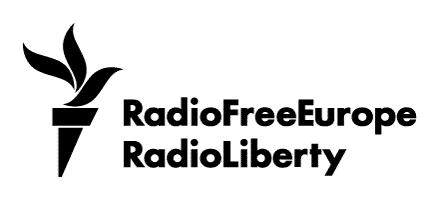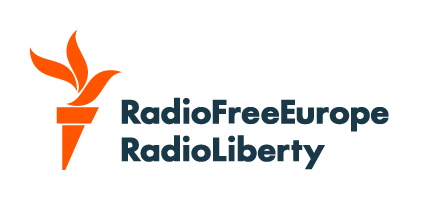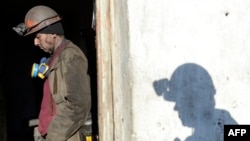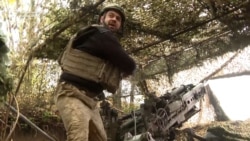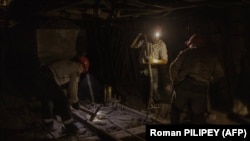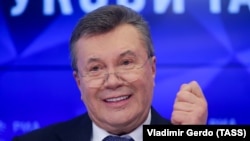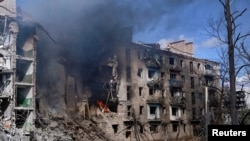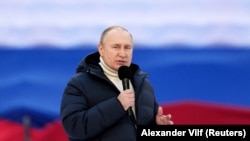At a tense White House meeting with Volodymyr Zelenskyy, US President Donald Trump pushed the Ukrainian leader, telling him he would probably have to give up swaths of Ukrainian land to end the war with Russia.
"We think that what they should do is just stop at the lines where they are, the battle lines," Trump told reporters aboard Air Force One two days later. "The rest is very tough to negotiate if you're going to say, 'You take this, we take that.'"
"Let it be cut the way it is. It's cut up right now. I think 78 percent of the land is already taken by Russia," he said on October 19. "You leave it the way it is right now. They can...negotiate something later on down the line.”
Trump was referring in large part to land in a section of eastern and southeastern Ukraine known as the Donbas.
Last spring, Zelenskyy backed Trump’s call for a cease-fire that would leave Russia in control of parts of the Donbas and other regions for the time being.
But for the overwhelming majority of Ukrainians, giving up the Donbas or any other territory formally or permanently is out of the question: “We will not leave the Donbas. We cannot do that,” Zelenskyy said in August.
Trump’s suggestion that Ukraine would have to give up land appeared to diverge from his remarks last month, when he claimed Kyiv was “in a position to fight and WIN all of Ukraine back in its original form.”
While the White House may be shifting in its thinking about Ukrainian territory, the Kremlin is not.
The Donbas remains central to Putin’s political and military priorities -- the entire region is scarred by a long section of the zigzagging 1,100-kilometer front line. To Moscow, its importance -- economic, cultural, and historic -- stretches back decades, if not centuries.
So why exactly is the Kremlin fixated on the Donbas?
Industrial Heartland
A geographic term deriving from the Donets River and the word “basin” -- as in coal basin -- the Donbas encompasses the entirety of two Ukrainian regions -- Luhansk and Donetsk. By some definitions, it also includes small parts of the neighboring regions of Kharkiv, Dnipropetrovsk, and Zaporizhzhya.
It’s Ukraine’s industrial heartland -- home to coal mines, smelters, metallurgical plants, ports, railways, and other heavy industry.
At around 52,000 square kilometers, the region is roughly the size of Croatia.
The Donbas’s southern stretches include some of the rich agriculture lands that Ukraine is famous for. The Sea of Azov coastline in southern Donetsk is home to the port of Mariupol and to Azovstal --until 2022, one of the largest steel facilities in the world.
Soviet leaders saw the Donets River region -- its coal and its smelters -- as the engine for crash-course industrialization, to haul the Soviet Union toward economic parity with European industrial powers like Germany.
After the economic shock of the Soviet collapse in 1991, the region began a slow decline, taking on a Rust Belt quality, suffering from outdated infrastructure, a lack of investment, a shift in production capacity, and competition from global markets and world trade.
Some of Ukraine’s wealthiest businessmen hailed from the Donbas, bankrolling the Party of the Regions political bloc and its leader, Viktor Yanukovych, who served stints as president and prime minister.
Yanukovych fled to Russia in February 2014 after months of mass demonstrations in Kyiv culminated in violent street clashes.
In the months that followed, Russia launched an insurgency and campaign of sabotage and destabilization in the Donbas, seizing military installations and key buildings, including the region’s unofficial capital, Donetsk. Russia also sent regular troops into full battle against Ukraine’s under-equipped and undermanned forces in several battles.
Russia-backed forces declared “people’s republics” in Donetsk and Luhansk, which later became the basis for Putin’s 2022 declaration to have annexed the two regions, along with two other regions.
Prior to February 2022, Russia’s proxies controlled around 42,000 square kilometers of Ukrainian territory, entirely in the Donbas, plus the Black Sea peninsula of Crimea, which was seized eight years earlier.
The Donbas Fortress Belt
Russian forces captured several key Donbas cities in the first year of the all-out invasion.
Mariupol fell in May 2022 after a brutal three-month siege; Syevyerodonetsk, to the north, was captured the following month. A year later, Bakhmut -- a Donetsk region city whose defense Zelenskyy and his commanders had prioritized -- fell to Russian troops.
After Bakhmut’s fall, Ukrainian planners prioritized a “fortress belt” of fortifications along two stronghold cities -- Slovyansk and Kramatorsk -- along with the rail juncture city of Kostyantynivka, further to the south.
Stretching roughly 50 kilometers in total, the belt is a sinuous line of defenses -- trenches, anti-tank obstacles, bunkers, minefields -- woven into the urban sprawl around the cities.
For Russia, overcoming the fortress belt would allow forces to move quickly west to the border of the Donetsk region, putting the Kremlin priority -- seizing the entirety of the Donbas -- within reach.
Losing the fortress belt would pose a longer-term risk for Ukrainian forces, paving the way for new Russian operations in the future -- something Zelenskyy alluded to in August: “The Donbas is a springboard for a future new offensive.”
"The demands on Ukraine to hand over the remaining part of the Donetsk region are unrealistic from the point of view of Ukraine's future defense capabilities,” Kirill Martynov, the editor in chief of the exiled Russia newspaper Novaya Gazeta Europe, told Current Time.
“Putin has been trying to conquer the Donetsk region for 11 years. And handing over to him those fortified areas that remain under Ukrainian control is effectively a path to Kharkiv and Dnipro,” he said referring to two capitals of neighboring regions. “And, by and large, a path to a new war in which it will be even easier for Putin to win.”
Novorossia
The roots of the Kremlin’s claims on the Donbas -- not to mention most of Ukraine -- date in part to the 18th century when Catherine the Great expanded Russia’s imperial conquests south to the Black Sea coast and west toward the Balkans.
Termed Novorossia, or New Russia, the concept was embraced by modern-day Russian nationalists and philosophers -- Aleksandr Dugin most prominently -- who also promoted the wider idea of a Russky Mir, or Russian World. Putin took up the idea publicly shortly after the seizure of Crimea, a territory that holds deep emotional resonance for many Russians.
In the Donbas, ethnic Ukrainians were the dominant nationality until the years after World War II, when Soviet planners started importing ethnic Russians to repopulate the region and build an industrial labor force.
By the time of the Soviet collapse, the Donbas had a higher proportion of people reporting themselves as ethnic Russians than any other region aside from Crimea, though still the minority.
Prior to the outbreak of war in 2014, the Russian language was widely used in the Donbas and other parts of Ukraine. Zelenskyy, who hails from the south-central city of Kryviy Rih, grew up speaking Russian as his first language, for example.
Over the years, Ukrainian nationalists periodically sought to downgrade Russian across the country, and there were sporadic unsuccessful referendum efforts to cement the Russian language as a state language alongside Ukrainian.
Russian nationalists have claimed that the Donbas’s ethnic Russians want to secede and unify with Russia itself, which is contradicted by several elections and referendums held over the years.
The region was home to around 6 million people prior to 2022. In the run-up to the invasion, the Kremlin sought to justify its war in part by portraying the ethnic Russian minority as being victims of a state campaign of discrimination.
In his televised address on February 24, 2022, announcing the invasion, Putin spoke falsely of a “genocide that almost 4 million people are being subjected to.” Two years later, Russia filed a claim with the United Nations’ highest court, alleging genocide in the Donbas.


